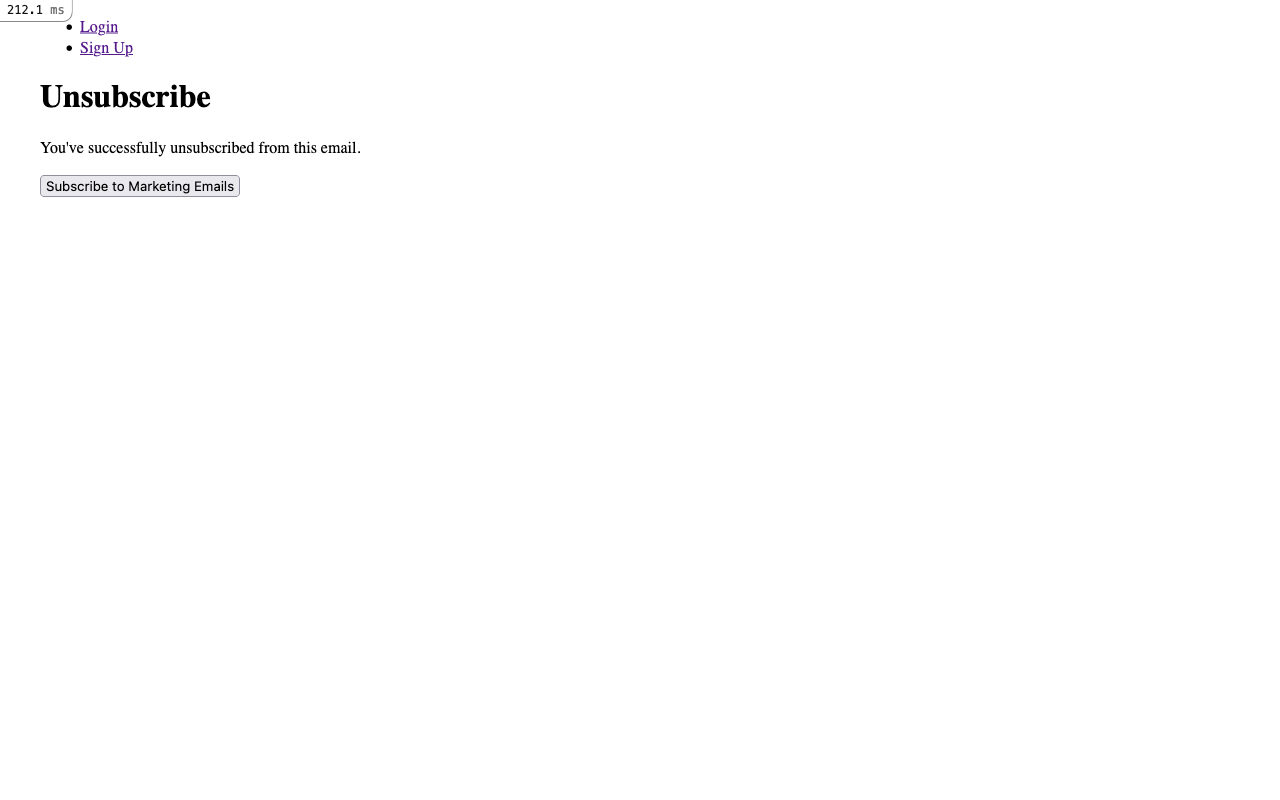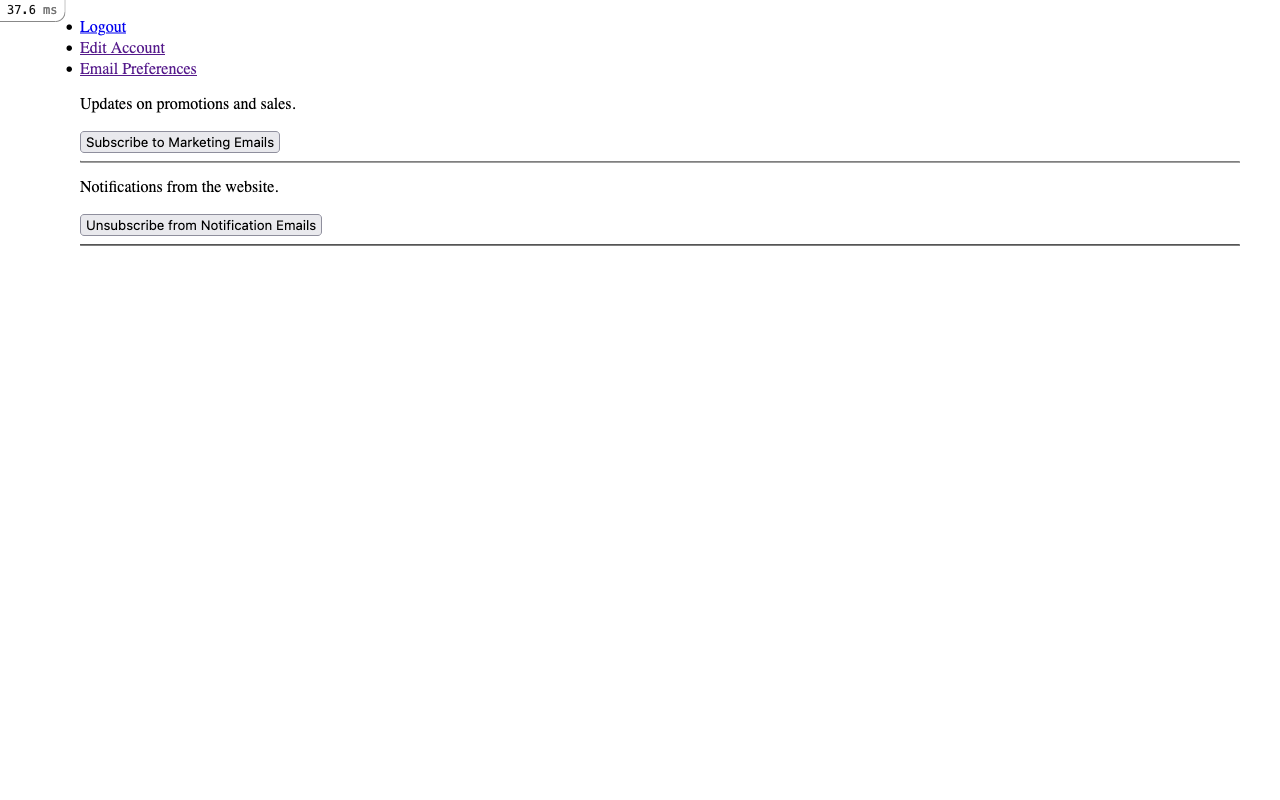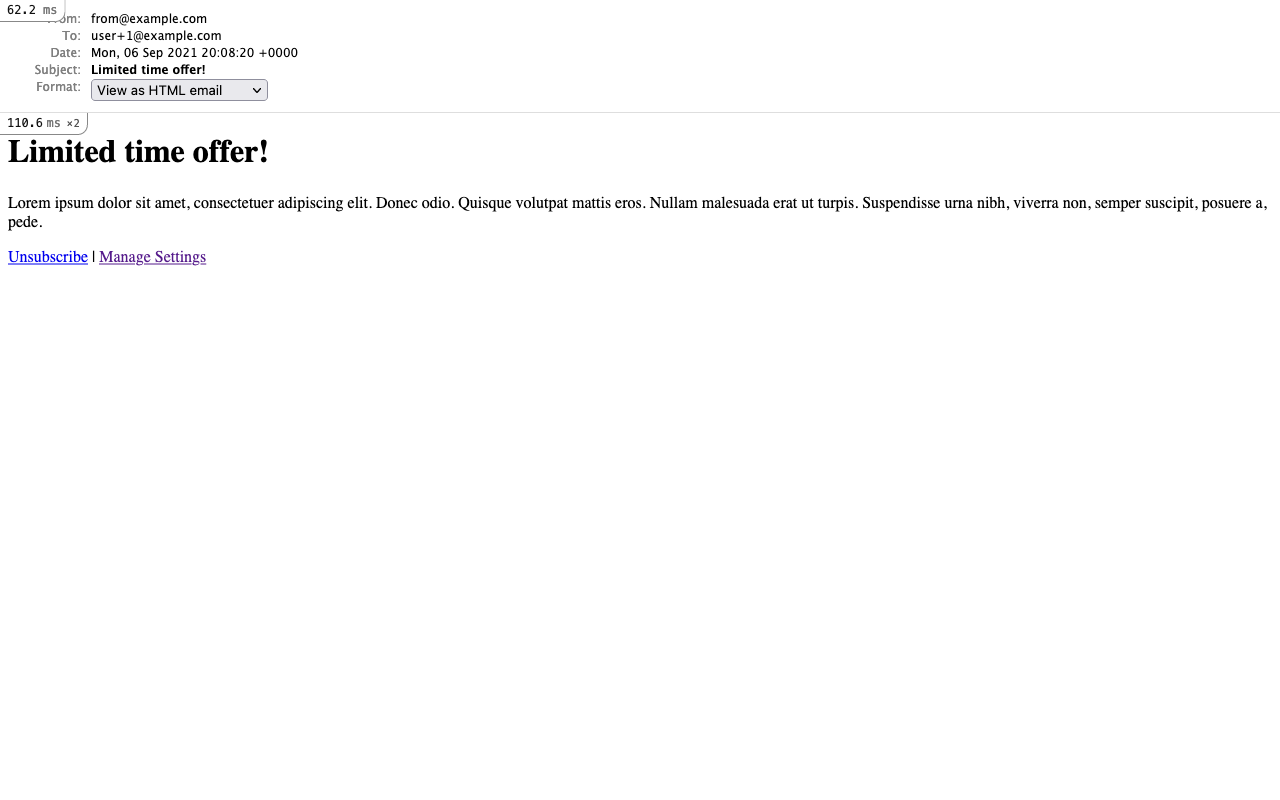Automatically Unsubscribe from Emails in Rails (and Control Email Preferences)
In this tutorial, I’ll show you how to add a link to any Rails Mailer that will allow a user to automatically unsubscribe from that email. As an added bonus, we’ll build a page allowing a user to update their email preferences across all mailers.
Inspired by GoRails.
Step 1: Build Mailers
-
Generate mailers.
rails g mailer marketing promotion rails g mailer notification notify -
Update previews by passing a user into the mailer. This assumes your database has at least one user record.
# test/mailers/previews/marketing_mailer_preview.rb class MarketingMailerPreview < ActionMailer::Preview def promotion MarketingMailer.with(user: User.first).promotion end end# test/mailers/previews/notification_mailer_preview.rb class NotificationMailerPreview < ActionMailer::Preview def notify NotificationMailer.with(user: User.first).notify end end
Step 2: Build a Model to Save Email Preferences
-
Generate the model and migration.
rails g model mailer_subscription user:references subscribed:boolean mailer:string -
Add a null constraint to the mailer column, and a unique index on the user_id and mailer columns. This will prevent duplicate records.
class CreateMailerSubscriptions < ActiveRecord::Migration[6.1] def change create_table :mailer_subscriptions do |t| t.references :user, null: false, foreign_key: true t.boolean :subscribed t.string :mailer, null: false t.timestamps end add_index(:mailer_subscriptions, [:user_id, :mailer], unique: true) end endWhat’s Going On Here?
- We add
null: falseto themailercolumn to prevent empty values from being saved, since this column is required. - We add a unique index on the
user_idandmailercolumns to prevent a user from having multiple preferences for a mailer.
- We add
-
Run the migrations.
rails db:migrate -
Build the MailerSubscription model.
# app/models/mailer_subscription.rb class MailerSubscription < ApplicationRecord belongs_to :user MAILERS = OpenStruct.new( items: [ { class: "MarketingMailer", name: "Marketing Emails", description: "Updates on promotions and sales.", }, { class: "NotificationMailer", name: "Notification Emails", description: "Notifications from the website.", }, ], ).freeze validates :subscribed, inclusion: [true, false], allow_nil: true validates :mailer, presence: true validates :mailer, inclusion: MAILERS.items.map { |item| item[:class] } validates :user, uniqueness: { scope: :mailer } # @mailer_subscription.details # => [{:class => "MarketingMailer", :name => "Marketing Emails", :description => "Updates on promotions and sales."}] def details MailerSubscription::MAILERS.items.select { |item| item[:class] == mailer } end # @mailer_subscription.name # => "Marketing Emails" def name details[0][:name] end # @mailer_subscription.name # => "Updates on promotions and sales." def description details[0][:description] end # @mailer_subscription.name # => "Subscribe to" def action subscribed? ? "Unsubscribe from" : "Subscribe to" end # @mailer_subscription.name # => "Subscribe to Marketing Emails" def call_to_action "#{action} #{name}" end endWhat’s Going On Here
- We add a constant to store a list of mailers a user will be able to subscribe/unsubscribe from. The class value must match the name of a Mailer class.
- We use the values stored in the constant to constrain what values can be set on the
mailercolumn. This prevents us from accidentally creating a record with an invalid mailer. - We add a uniqueness validator between the
userandmailer. This is made possible by the unique index we created in the migration. This will ensure a user cannot have multiple preferences for the same mailer. - We use the values stored in the constant to create a variety of helper methods that can be used in views.
-
Add method to check if a user is subscribed to a specific mailer.
# app/models/user.rb class User < ApplicationRecord has_many :mailer_subscriptions, dependent: :destroy # @user.subscribed_to_mailer? "MarketingMailer" # => true def subscribed_to_mailer?(mailer) MailerSubscription.find_by( user: self, mailer: mailer, subscribed: true, ).present? end end
What’s Going On Here?
- We add a method that checks if a user is subscribed to a particular mailer. If the method finds a matching record, then the user is subscribed. Otherwise, they are not. Note that this is an opt-in strategy. We’re deliberately looking for records where
subscribedis set totrue. This means that if there is no record in the database, they’ll be considered unsubscribed.- To make this an opt-out strategy, you could simply replace
subscribed: truewithsubscribed: false.
Step 3: Allow a User to Automatically Unsubscribe from a Mailer
-
Generate a controller to handle automatic unsubscribes.
rails g controller mailer_subscription_unsubcribes# config/routes.rb Rails.application.routes.draw do ... resources :mailer_subscription_unsubcribes, only: %i[show update] end -
Build the endpoints.
# app/controllers/mailer_subscription_unsubcribes_controller.rb class MailerSubscriptionUnsubcribesController < ApplicationController before_action :set_user, only: %i[show update] before_action :set_mailer_subscription, only: %i[show update] def show if @mailer_subscription.update(subscribed: false) @message = "You've successfully unsubscribed from this email." else @message = "There was an error" end end def update if @mailer_subscription.toggle!(:subscribed) redirect_to root_path, notice: "Subscription updated." else redirect_to root_path, notice: "There was an error." end end private def set_user @user = GlobalID::Locator.locate_signed params[:id] @message = "There was an error" if @user.nil? end def set_mailer_subscription @mailer_subscription = MailerSubscription.find_or_initialize_by( user: @user, mailer: params[:mailer], ) end end -
Build the view.
<%# app/views/mailer_subscription_unsubcribes/show.html.erb %> <h1>Unsubscribe</h1> <p><%= @message %></p> <%= button_to @mailer_subscription.call_to_action, mailer_subscription_unsubcribe_path, method: :patch, params: { mailer: params[:mailer] } if @mailer_subscription.present? %>
You can test this be getting the Global ID of a user and going to the endpoint.
User.first.to_sgid.to_s
# => "abc123..."
http://localhost:3000/mailer_subscription_unsubcribes/abc123…?mailer=MarketingMailer
What’s Going On Here?
- We create an endpoint that will automatically unsubscribe a user from a particular mailer. This is a little unconventional since we’re creating a record on a GET request (instead of a POST request). We’re forced to do this because a user will be clicking a link from an email to unsubscribe. If emails supported forms, we could create a POST request.
- We add a button on that page that will allow the user to resubscribe to the mailer. Note that we don’t redirect back to the
showaction because that would end up unsubscribing the user from the mailer again.- We find the user through their GlobalID in the URL which makes the URLs difficult to discover. Otherwise the URL would just accept the user’s ID which is much easier to guess. This will prevent a bad actor from from unsubscribing a user from a mailer.
Step 4: Build a Page for User to Update Their Email Preferences
-
Generate a controller for the MailerSubscription model.
rails g controller mailer_subscriptions# config/routes.rb Rails.application.routes.draw do resources :mailer_subscription_unsubcribes, only: %i[show update] resources :mailer_subscriptions, only: %i[index create update] end -
Build the endpoints.
# app/controllers/mailer_subscriptions_controller.rb class MailerSubscriptionsController < ApplicationController before_action :authenticate_user! before_action :set_mailer_subscription, only: :update before_action :handle_unauthorized, only: :update def index @mailer_subscriptions = MailerSubscription::MAILERS.items.map do |item| MailerSubscription.find_or_initialize_by(mailer: item[:class], user: current_user) end end def create @mailer_subscription = current_user.mailer_subscriptions.build(mailer_subscription_params) @mailer_subscription.subscribed = true if @mailer_subscription.save redirect_to mailer_subscriptions_path, notice: "Preferences updated." else redirect_to mailer_subscriptions_path, alter: "#{@mailer_subscription.errors.full_messages.to_sentence}" end end def update if @mailer_subscription.toggle!(:subscribed) redirect_to mailer_subscriptions_path, notice: "Preferences updated." else redirect_to mailer_subscriptions_path, alter: "#{@mailer_subscription.errors.full_messages.to_sentence}" end end private def mailer_subscription_params params.require(:mailer_subscription).permit(:mailer) end def set_mailer_subscription @mailer_subscription = MailerSubscription.find(params[:id]) end def handle_unauthorized redirect_to root_path, status: :unauthorized, notice: "Unauthorized." and return if current_user != @mailer_subscription.user end endWhat’s Going On Here?
- We create a page allowing a user to subscribe/unsubscribe from all possible mailers that are defined in
MailerSubscription::MAILERS. We can’t call@user.mailer_subscriptionsbecause they may not have any records. - We create a
handle_unauthorizedmethod to prevent a user from subscribing/unsubscribing another user from mailers. We need to do this because we’re passing in the ID of theMailerSubscriptionthrough the params hash which can be altered via the browser.
- We create a page allowing a user to subscribe/unsubscribe from all possible mailers that are defined in
-
Build the views.
<%# app/views/mailer_subscriptions/index.html.erb %> <ul style="list-style:none;"> <%= render @mailer_subscriptions %> </ul><%# app/views/mailer_subscriptions/_mailer_subscription.html.erb %> <% if mailer_subscription.new_record? %> <li style="margin-bottom: 16px;"> <p><%= mailer_subscription.description %></p> <%= button_to mailer_subscriptions_path, params: { mailer_subscription: mailer_subscription.attributes } do %> <%= mailer_subscription.call_to_action %> <% end %> <hr/> </li> <% else %> <li style="margin-bottom: 16px;"> <p><%= mailer_subscription.description %></p> <%= button_to mailer_subscription_path(mailer_subscription), method: :put do %> <%= mailer_subscription.call_to_action %> <% end %> <hr/> </li> <% end %>
What’s Going On Here?
- We loop through each
MailerSubscriptioninstance. If it’s a new_record? we create aMailerSubscription. Otherwise, it’s an existing record and we toggle! thesubscribedvalue.- In either case we use a button_to to hit the correct endpoint. Note that when we’re creating a new
MailerSubscriptionwe passmailer_subscription.attributesas params, but we’re only permitting themailervalue in our controller.
http://localhost:3000/mailer_subscriptions
Step 5: Add Unsubscribe Link to Mailer and Prevent Delivery if User Has Unsubscribed
-
Add shared logic to
ApplicationMailer.# app/mailers/application_mailer.rb class ApplicationMailer < ActionMailer::Base before_action :set_user before_action :set_unsubscribe_url, if: :should_unsubscribe? before_action :set_mailer_subscriptions_url, if: :should_unsubscribe? after_action :prevent_delivery_if_recipient_opted_out, if: :should_unsubscribe? default from: 'from@example.com' layout 'mailer' private def prevent_delivery_if_recipient_opted_out mail.perform_deliveries = @user.subscribed_to_mailer? self.class.to_s end def set_user @user = params[:user] end def set_unsubscribe_url @unsubscribe_url = mailer_subscription_unsubcribe_url(@user.to_sgid.to_s, mailer: self.class) end def set_mailer_subscriptions_url @mailer_subscriptions_url = mailer_subscriptions_url end def should_unsubscribe? @user.present? && @user.respond_to?(:subscribed_to_mailer?) end endWhat’s Going On Here?
- We add several action mailer callbacks to the
ApplicationMailerin order for this logic to be shared across all mailers. - We call
prevent_delivery_if_recipient_opted_outwhich will conditionally prevent the mailer from being sent if the user is not subscribed to that mailer. This is accomplished by settingmail.perform_deliveriestotrueorfalsebased on the return value of@user.subscribed_to_mailer? self.class.to_s. Note that callingself.class.to_swill return the name of the mailer (i.e. MarketingMailer). - We call
@user.to_sgid.to_sto ensure the the URL is unique and does not contain the user’s id. Otherwise a bad actor could unsubscribe any user from a mailer. - We conditionally call these callbacks with
should_unsubscribe?to ensures we’ve passed a user to the mailer.
- We add several action mailer callbacks to the
-
Conditionally render unsubscribe links in mailer layouts.
<%# app/views/layouts/mailer.html.erb %> <!DOCTYPE html> <html> ... <body> <%= yield %> <%= render "shared/mailers/unsubscribe_links" if @unsubscribe_url.present? %> </body> </html><%# app/views/layouts/mailer.txt.erb %> <%= yield %> <%= render "shared/mailers/unsubscribe_links" if @unsubscribe_url.present? %>




